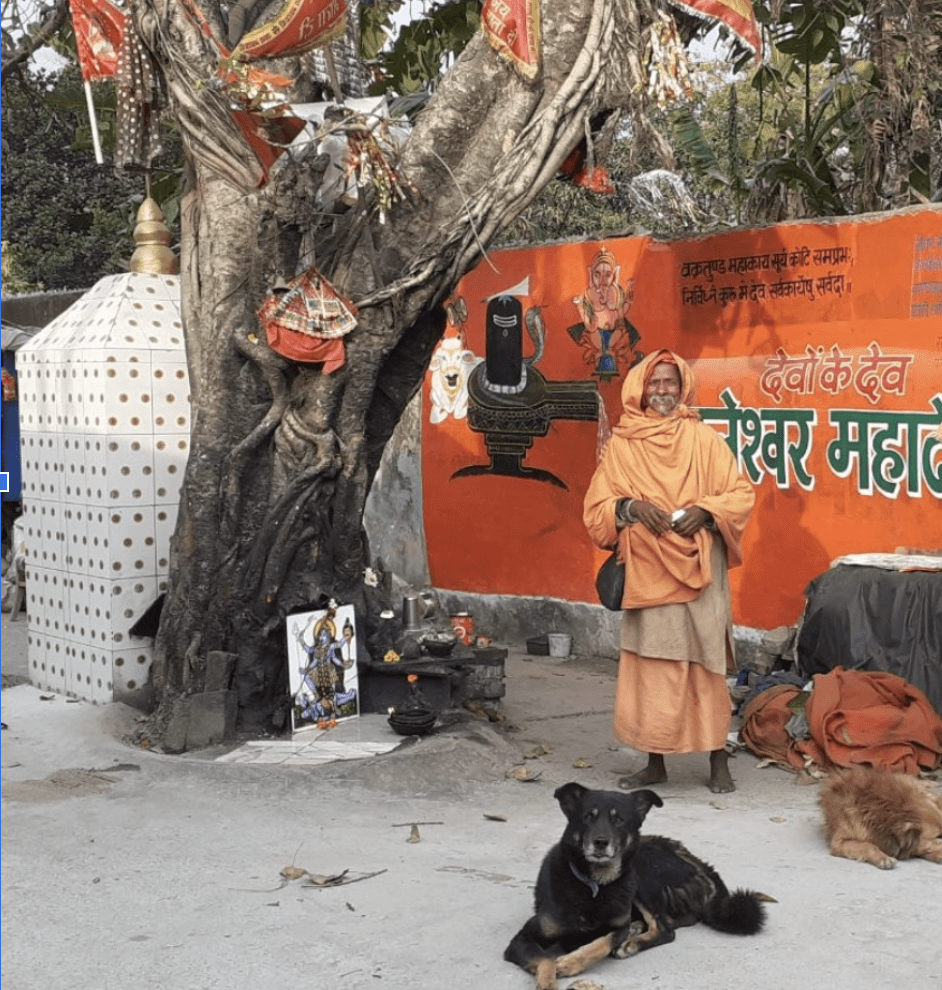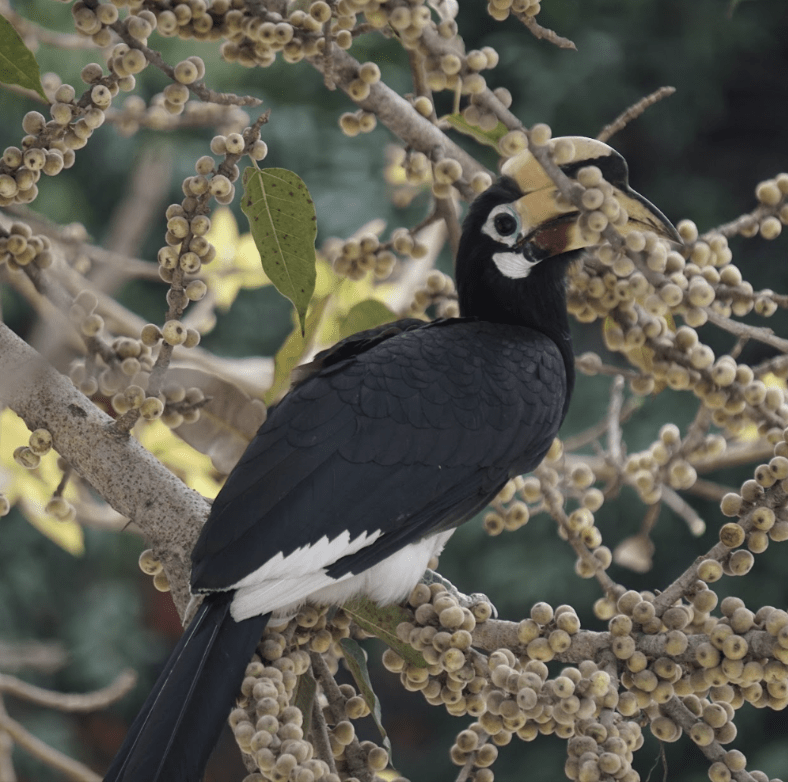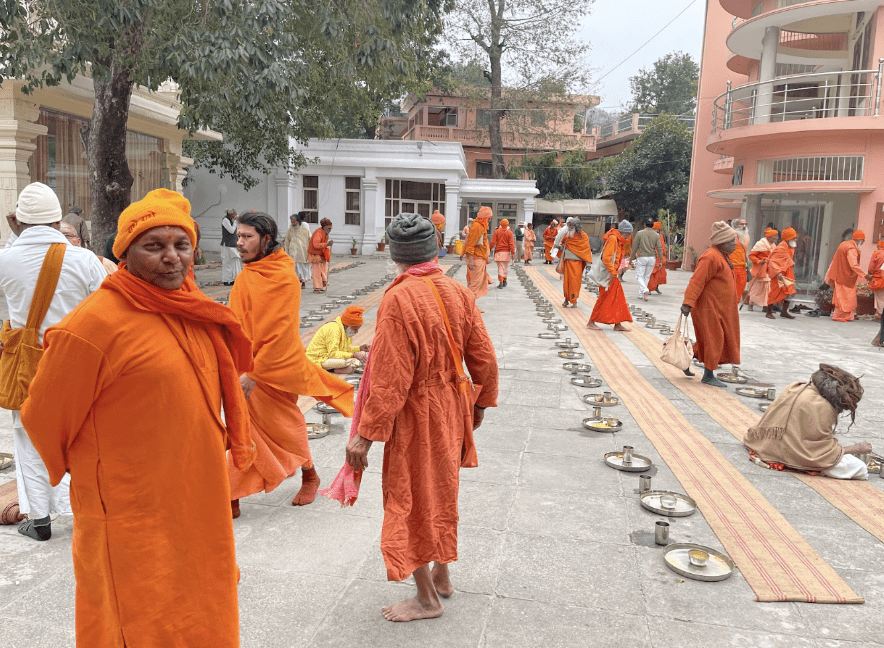Comparative Module on Mindfulness (to be used in various content courses)
Developed by Lazaara Ilieva and Rajni Bhargava 
Age: High school or college
Objectives: Students will be able to:
- compare and contrast the concept of Gaia, Buddhist idea of compassion and Upanishadic idea of one-ness
- understand and exercise compassion and care toward other beings, by embodying the perspective of others
Performance Tasks:
Interpersonal: In pairs, students develop a Venn Diagram of the three traditions to outline similarities and differences
Presentational: Creative Writing Activity — The task is in the context of a course where students have been reading stories (e.g., Bhole Baba Ji and his temple https://www.youtube.com/watch?v=XrfzoyDWnAE)
Instructions: Choose a story that we have come across in class, and rewrite it from the perspective of a (human or non-human) actor that was not given a voice in the story. (e.g., write the story of Bhole Baba Ji from the perspective of the tree).
 Connection to Content: The concept of interconnectedness in Gaia hypothesis, Buddhism, Upanishadic thought that teaches respect for life, non-harming (ahimsa) and ultimately, infinite compassion and mindful actions. This shared concept provides a framework for understanding the relationship between humans and the environment, the importance of maintaining a harmonious relationship with the Earth for the well-being of both humans and the planet, and how this relationship impacts mental health.
Connection to Content: The concept of interconnectedness in Gaia hypothesis, Buddhism, Upanishadic thought that teaches respect for life, non-harming (ahimsa) and ultimately, infinite compassion and mindful actions. This shared concept provides a framework for understanding the relationship between humans and the environment, the importance of maintaining a harmonious relationship with the Earth for the well-being of both humans and the planet, and how this relationship impacts mental health.
Background Content:
Mindfulness, Gaia, Buddhism, and Upanishadic thought all share a deep connection to the nature of existence and our place within it. Mindfulness, rooted in Buddhist practice, is the practice of being fully present and aware of one’s thoughts, feelings, sensations, and surroundings. It involves cultivating a non-judgmental awareness of the present moment. Mindfulness can help individuals recognize their interconnectedness with the world around them and develop a deeper sense of compassion and empathy.
Buddhism places a strong emphasis on compassion (karuna) towards all beings, which arises from the recognition of our interconnectedness. This compassion extends not only to other humans but also to all living beings and the Earth itself.
The Upanishads are ancient philosophical texts that explore the nature of reality, the self, and the ultimate reality (Brahman). Upanishadic thought emphasizes the concept of oneness, suggesting that the individual self (Atman) is ultimately identical with the universal self (Brahman). This idea of oneness aligns with the Gaia hypothesis and the Buddhist concept of interconnectedness.
The Gaia concept and hypothesis, proposed by James Lovelock, suggests that the Earth is a self-regulating system in which all living organisms interact with their inorganic surroundings to maintain conditions suitable for life. This hypothesis emphasizes the interconnectedness and interdependence of all life forms on Earth, mirroring the Buddhist concept of interconnectedness.
 Gaia theory, Buddhism, and Upanishadic thought all emphasize the interconnectedness of all beings. In addition, Upanishadic thought emphasizes the oneness of all existence. All three traditions emphasize the importance of preserving the balance and health of the Earth’s ecosystems based on the principle of non-harming (ahinsa). The Gaia hypothesis can be seen as a scientific validation of this compassionate attitude, as it highlights the importance of caring for the Earth and all its inhabitants. They lead to respect for life and to conscious behaviors that include caring for the environment, supporting sustainable practices, and promoting harmony between humans and nature.
Gaia theory, Buddhism, and Upanishadic thought all emphasize the interconnectedness of all beings. In addition, Upanishadic thought emphasizes the oneness of all existence. All three traditions emphasize the importance of preserving the balance and health of the Earth’s ecosystems based on the principle of non-harming (ahinsa). The Gaia hypothesis can be seen as a scientific validation of this compassionate attitude, as it highlights the importance of caring for the Earth and all its inhabitants. They lead to respect for life and to conscious behaviors that include caring for the environment, supporting sustainable practices, and promoting harmony between humans and nature.
The ideas are related to the mental health of humans in several ways. They promote a sense of connection to nature, which has been linked to improved mental health and well-being. Spending time in nature, known as “ecotherapy,” has been shown to reduce stress, anxiety, and depression. Caring for the environment results in maintaining conditions favorable for life. This awareness provides a sense of purpose and belonging, which are important for mental health. Feeling connected to something larger than oneself can promote a sense of meaning and fulfillment. However, environmental degradation caused by human activities such as pollution and deforestation, disrupt the balance of nature and humans, have negative effects on mental health, including increased stress and anxiety about the future of the planet. The three traditions encourage a holistic view of health, considering the interconnectedness of physical, mental, and environmental health. They promote a m ore comprehensive understanding of mental health and well-being.
ore comprehensive understanding of mental health and well-being.
References:
Batchelor, S. (2010). Confession of a Buddhist atheist. Spiegel & Grau.
Kabat-Zinn, J. (1994). Wherever you go, there you are: Mindfulness meditation in everyday life. Hyperion.
Kirchner, J. W., & Weil, A. (2000). Delayed biological recovery from extinctions throughout the fossil record. Nature, 404(6774), 177-180.
Lovelock, J. E. (1979). Gaia: A new look at life on Earth. Oxford University Press.
Radhakrishnan, S. (1992). The principal Upanishads. HarperCollins.
Schneider, S. H., Miller, J. R., Crist, E., & Boston, P. J. (Eds.). (2010). Scientists debate Gaia: The next century. MIT Press.
Williams, P., & Tribe, A. (2000). Buddhist thought: A complete introduction to the Indian tradition. Routledge.
Peepaleshwar Maharaj’s Tree
Bhole Baba’s parents were wandering ascetics. They settled in an ashram in Rishikesh run by a great teacher Maharaj from Kerala, who gave them a place to stay. Baba stayed there and served the great teacher, and eventually became his disciple. The swami Maharaj would take Baba on journeys with him, including the pilgrimage Char Dham and Allahabad. Maharaj’s body was nearing its end. One day, as they were walking towards the banks of the Ganga River from the ashram, they came across a tree. Baba said to Maharaj, “Bhole Baba, after you leave this world, I will take care of this tree.” Baba had seen many trees cut because of expanding construction work in Rishikesh.
The ashram passed into someone else’s hands. Baba did not like the people who were running the ashram nor the way they were doing it. One day, the great teacher said to Baba, “Make my bed, I have to leave tomorrow.” That night, he sat in meditation and said, “All of you sit outside and make sure no one comes in.” There was a famous Mahatma Sushilanand Maharaj who lived at Triveni ghat and Baba’s guru had told him to call him in the morning and tell him to come quickly with garlands and flowers because he was getting ready to leave early in the morning. In the morning, Maharaj Sushilanand Ji came by 6:30am, but by then, Maharaj Ji had already left his body at 4:00am. When the procession was leaving for the banks of the Ganga, Baba ji thought that there was nothing left for him to do in this ashram and he left with the procession. He had brought along a few clothes and sticks for the pyre, and never looked back. He never returned to that ashram.
One day, Baba went to the municipal headquarters and told them, “Sir, there is a tree near the SSP camp, let’s go there.” They went with Baba to that place on a Sunday. Showing them the tree, Baba said, “I like this place, I want to stay here.” They arranged for him to stay there. Near Mayapuri in Rishikesh, there is a school where Matke wala Baba lived in a hut. There were two red Matke there and several peepal trees. But it was not long before construction to expand the road started and these trees were cut down. Then Baba Ji decided that it was his urgent duty to protect the tree near him. He believed that the tree gave humans clean and fresh air, shade during the hot days, and if you slept under it, you would get very good sleep. That is why he decided that it was his sacred duty to protect it. Bhole Baba considered himself blessed. It became his home, the ground right next to the tree and he was very happy living under that tree. He started caring for that peepal tree. He would do his worship in the morning and in the evening. With time, people from the neighborhood would notice him, stop by and chat with him. They often join him in the puja and brought chay or some food for him. Several statues and images were also installed on and around the tree. His temple grew. Sometimes, when a wedding was going on in the neighborhood, they would send money to Bhole Baba Ji as a token of good luck. No one returned hungry from his place, the tree-temple. Baba served tea, water, and food to everyone who would stop by. He would go daily to fetch water from Ganga. He kept everyone happy, did not make anyone work for him. He did all himself and he never begged. But one day, in his sleep, he was attacked, but there was nothing that he owned that could be stolen. He almost died, but people knew him and helped him get admission in the hospital. It took him a long time to recover and he came back. His life was peaceful and happy again. Bhole Baba Ji asked for legal protection of the tree and the municipality acknowledged it as a temple in an official certificate on his name as the head priest. People would see him and say, “This is the peepal tree-temple, in which Peepaleshwar Maharaj resides”.
Source: https://www.youtube.com/watch?v=XrfzoyDWnAE
पीपलेश्वर महाराज का पेड़
पीपलेश्वर महाराज बाबा के माता पिता बचपन में ही चल बसे थे। ऋषिकेश के आश्रम में केरल के रहने वाले एक महात्मा थे, उन्होंने ही उन्हें आश्रम में रहने की जगह दी। वहाँ रहकर बाबा महात्मा की सेवा करते थे और उनके चेले बन गए । महात्मा यात्रा पर उन्हें अपने साथ जगह-जगह ले जाते थे। उन्हीं के साथ उन्होंने चार धाम की यात्रा और अलाहबाद की यात्रा की। महाराज का शरीर पूरा होने जा रहा था। एक दिन वे आश्रम से गंगा की ओर जा रहे थे और रास्ते में एक पेड़ आया तो बाबा ने महाराज से कहा, “ भोले बाबा आप के जाने के बाद मैं इस पेड़ की सेवा करूँगा”। गुरुजी का आश्रम किसी और के हाथ में चला गया था । आश्रम जिन लोगों के हाथ में गया था, उन्हें बाबा ज़्यादा पसंद नहीं करते थे। महात्मा ने एक दिन बाबा से कहा, “ मेरा बिस्तर ठीक कर दो, मुझे कल जाना है”।रात को वे आपने आप समाधि में बैठ गए और उन्होंने कहा, “तुम सब बाहर बैठो और ध्यान रखना कोई अंदर न आए।” महात्मा सुशीला नंद जी महाराज तिरूमन घाट पर रहते थे और बाबा के गुरु ने उनसे कहा, और महाराज जो तिरूमन घाट पर रहते हैं, उन्हें सुबह फ़ोन कर के बुलाना और कहना कि वे माला, फूल लेते हुए आएँ और जल्दी आएँ क्योंकि सुबह जल्दी जाना है।” सुबह महाराज सुशिलानंद जी साढ़े आठ बजे तक आए और तब तक चार बजे तक तो महाराज जी जा चुके थे । महाराज जी को कपड़े पहना कर, तैय्यार कर के, जब उनकी बारात गंगा की तरफ़ निकल रही थी, तब बाबा के मन में आया कि अब इस आश्रम में उनके लिए कुछ रहा नहीं है , उन्हीं के साथ निकल जाना चाहिए। उनके जो दिए हुए कपड़े –लत्ते थे, साथ में लिए और फिर कभी उस आश्रम की तरफ़ मुड़ कर नहीं देखा। एक दिन बाबा नगर पालिका गए और वहाँ के जो नेता जी थे, उनसे कहा, “साहब, SSP कैम्प के पास एक पेड़ है, आप वहाँ चलो ।वे बाबा के साथ उस रविवार को वहाँ गए। बाबा ने पेड़ दिखाते हुए कहा, “ मुझे यह जगह पसंद आयी है, मैं वहाँ रहना चाहता हूँ “। उन्होंने उसके लिए हामी भर दी । ऋषिकेश में मायापुरी के पास एक स्कूल है जहां मटके वाले बाबा रहते थे। वहाँ दो लाल घड़े रहते थे और एक पीपल का पेड़ था। जब सड़क चौड़ी करने का समय आया तब वह पेड़ कट गया तो बाबा को भी हटना पड़ा। तब स्वामी जी ने निर्णय लिया कि SSP कैम्प के पास जो पेड़ है, उसकी रक्षा करना उनका कर्तव्य है। उनका मानना है कि पेड़ आदमी को ताजी हवा देता है, गर्मी में छाया देता है और उसके नीचे सो जाओ तो बड़े आनंद की नींद आती है। इसीलिए उसकी रक्षा करना हमारा कर्तव्य है। वे उसे भोले बाबा की कृपा मानते हैं। उनकी जान पर एक बार जानलेवा हमला भी हुआ था और वह मरते मरते बचे । उनके पास रहने का कोई और ठिकाना नहीं है पर पेड़ के नीचे वे बहुत आनंद से रहते हैं। थोड़ा बहुत झाड़ –फूंक भी कर देते हैं। कभी शादी का न्यौता आता है तो बाबा को जो पैसे मिलते हैं , वो शगुन के तौर पर कार्ड के साथ भोले बाबा के नाम भिजवा देते हैं । कोई उनके यहाँ से भूखा नहीं लौटता है। बाबा सबको चाय पानी, खाना खिलवा देते हैं। सबको खुश रखते हैं, किसी से कोई काम नहीं कराते हैं।गंगा जी से पानी लेने जाते हैं । कभी भीख नहीं माँगते हैं।नगर निगम पालिका को इसकी मंदिर की मान्यता दे दी है और बाबा अब आधिकारिक तौर पर इस मंदिर के पुजारी हैं। इनका जीवन सुख शांति से बीत रहा है। बाबा कहते हैं, पेड़ में जो पीपलेश्वर महाराज हैं, वो उन्हें देखते हैं।